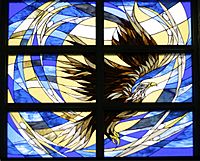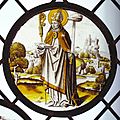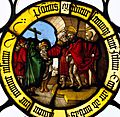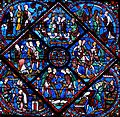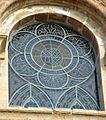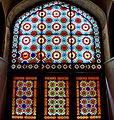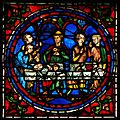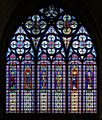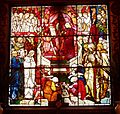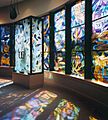Stained glass facts for kids

Stained glass is a special type of glass that gets its color from tiny bits of metallic salts added when it's made. These colorful pieces of glass are then used to create stained glass windows. Imagine a puzzle where small, bright pieces of glass are carefully put together to form beautiful pictures or patterns. These glass pieces are held in place by thin strips of lead and supported by a strong frame.
Sometimes, artists also paint details onto the glass or use a yellow stain to make the designs even better. The term "stained glass" can also mean windows where colors are painted directly onto the glass and then heated in a kiln to make them permanent.
Stained glass is very common in Christian art, especially in churches, but it's also used for many other things. It's still popular today and is often called art glass. You might see it in fancy homes or big buildings.
How Glass Gets Its Colors
The different colors in stained glass come from adding specific metal salts:
- Copper: This metal creates a deep, dark red glass.
- Gold: Even a tiny amount (like 0.001%) of gold can make a beautiful ruby red glass.
- Silver: Usually, silver nitrate is used to create colors ranging from red to yellow.
- Cobalt: This gives glass a brilliant blue color.
- Manganese dioxide: This makes glass green.
- Iron(II) oxide: This creates a blue-green shade.
- Chromium: This makes a dark green glass.
-
A modern art example by Theo van Doesburg from the De Stijl movement in the Netherlands (1917).
-
The Bald Eagle window at Dryden High School, USA. It's rare to see such active figures in stained glass.
Images for kids
-
The north rose window of the Chartres Cathedral in France, given by Blanche of Castile. It shows the Virgin Mary as Queen of Heaven, surrounded by kings and prophets. Below is St Anne, Mary's mother, with four good leaders. The window includes the symbols of France and Castile.
-
An outside view of a stained glass window from the Sint-Petrus-en-Pauluskerk in Ostend, Belgium, built between 1899 and 1908.
-
Part of a German panel from 1444 showing the Visitation. It uses different colored glass, black paint, yellow silver stain, and green enamel. The plant patterns in the red sky were made by scratching away black paint before heating.
-
German glass from Nuremberg, around 1525, based on a drawing by Sebald Beham. Silver stain creates yellow and gold colors, and paint on the back of the blue sky makes the dark green of the cross.
-
Swiss armorial glass from 1564, showing the Arms of Unterwalden. It has typical painted details, lots of silver stain, and ruby glass with a scraped white design.
-
The outside of a window at Sé Velha de Coimbra, Portugal, showing a modern steel frame.
-
The Thomas Becket window from Canterbury, showing the colored glass, lead strips, modern steel rods, and copper wire attachments.
-
Skilled glass cutting and leading in a 19th-century window at Meaux Cathedral, France.
-
A close-up from a 19th or 20th-century window in Eyneburg, Belgium, showing detailed painting of a face with many colors.
-
A perfume flask made of glass from 100 BC to 200 AD.
-
An alabaster window in Orvieto Cathedral, Italy.
-
Many stained glass windows at the Nasir-ol-Molk Mosque in Shiraz, Iran, with light shining through them.
-
Stained glass in Dowlat Abad Garden at Yazd, Iran.
-
This window from a mosque in Jerusalem has very detailed text.
-
A close-up of a 13th-century window from Chartres Cathedral.
-
Charlemagne from a Romanesque window in Strasbourg Cathedral.
-
The Crucifixion window of Poitiers Cathedral.
-
A Late Gothic Tree of Jesse window from Evreux Cathedral.
-
King David from Augsburg Cathedral, early 12th century. This is one of the oldest examples still in its original place.
-
Crucifixion with Ss Catherine, George and Margaret, Leechkirche, Graz, Austria.
-
The windows of the choir of Cologne Cathedral, (early 14th century).
-
A close-up of a Tree of Jesse from York Minster (around 1170), the oldest stained-glass window in England.
-
The Poor Man's Bible Window from Canterbury Cathedral.
-
South Transept window at Canterbury Cathedral, 13th century.
-
The west window of York Minster (1338–39).
-
The Last Judgement, St Mary's Church, Fairford, (1500–17) by Barnard Flower.
-
Stained-glass windows in the Toledo Cathedral (14th to 17th century).
-
A close-up of Apostles John and Paul, by Hardman of Birmingham, 1861–67. This is typical of Hardman's elegant figures and pure colors. St. Andrew's Cathedral, Sydney.
-
One of England's largest windows, the east window of Lincoln Cathedral, by Ward and Nixon (1855). It has a formal arrangement of small story scenes in round shapes.
-
By William Wailes. This window has bright pastel colors, lots of creative decorations, and typical gestures for windows from this company. St Mary's, Chilham.
-
By Clayton and Bell. A story window with elegant shapes and colors that are both bright and subtly mixed. Peterborough Cathedral.
-
A close-up of a "Tree of Jesse" window in Reims Cathedral, designed in the 13th-century style by L. Steiheil and painted by Coffetier for Viollet-le-Duc, (1861).
-
St Louis administering Justice by Lobin in a painterly style. (19th century) Church of St Medard, Thouars.
-
A brightly-colored window at Cassagnes-Bégonhès, Aveyron.
-
One of five windows given to Cologne Cathedral by Ludwig II.
-
A window in the Late Gothic style at St Maurice's Church, Olomouc, Czech Republic, early 20th century.
-
God the Creator by Stanisław Wyspiański. This window has no glass painting, relying only on lead lines and clever use of color and shade. Franciscan Church, Kraków (around 1900).
-
A window by Alfons Mucha at Saint Vitus Cathedral Prague. It has many images put together, creating an Expressionistic effect.
-
John La Farge, The Angel of Help, North Easton, MA. It shows tiny panes of glass next to large areas of shiny, opaque glass.
-
Religion Enthroned, J&R Lamb Studios, designed by Frederick Stymetz Lamb, around 1900. Brooklyn Museum. It has a balanced design, a limited color palette, and lots of mottled glass.
-
A trompe l'oeil (trick of the eye) glass from around 1884, by Eugène Stanislas Oudinot, designed by Richard Morris Hunt, for the home of Henry Gurdon Marquand, New York City.
-
An Expressionist window by Marc Chagall, at All Saints' Church, Tudeley, Kent, UK.
-
Christ of the Eucharist designed by Dom Charles Norris from Buckfast Abbey, Devon, England, made with slab glass.
-
Sergio de Castro, a close-up of the Jonah window for the Collegiate of Romont, Switzerland.
-
Postmodernist symbolism, Tree of Life at Christinae church, Alingsås, Sweden.
-
Thin slices of agate set into lead and glass, Grossmünster, Zürich, Switzerland, by Sigmar Polke (2009).
-
Madonna and Child by Joseph Ehrismann, late 1910s. (Église Saint-André, Meistratzheim). It combines a traditional image with an Art Nouveau style background.
-
A mid-20th-century window showing old and 19th-century methods used for a modern historical subject. The Florence Nightingale window at St Peters, Derby, made for the Derbyshire Royal Infirmary.
-
The amazing display of medieval glass at Sainte-Chapelle, Paris.
-
Sunlight shining through stained glass onto a colorful carpet at Nasir ol Molk Mosque.
-
St. Andrew's Cathedral, Sydney has a series of 19th-century windows by Hardman of Birmingham.
-
Coventry Cathedral England, has many windows by different designers.
-
Late 20th-century stained glass from Temple Ohev Sholom, Harrisburg, Pennsylvania by Ascalon Studios.
-
Stained glass in the crypt Mausoleum of the Cathedral of Our Lady of the Angels (Los Angeles).
-
Chapel stained glass showing the Resurrection of Jesus, All Saints Cemetery Community Mausoleum, Des Plaines, Illinois.
-
Stained glass in the Town Hall, Liberec, Czech Republic.
-
Windows of the Hungarian Room, University of Pittsburgh.
-
The Federal Palace, Switzerland.
-
An abstract design by Marcelle Ferron at a Metro station in Montreal, Quebec, Canada.
-
Windows by Mordecai Ardon at the Jewish National and University Library, Jerusalem.
See also
 In Spanish: Vitral para niños
In Spanish: Vitral para niños



